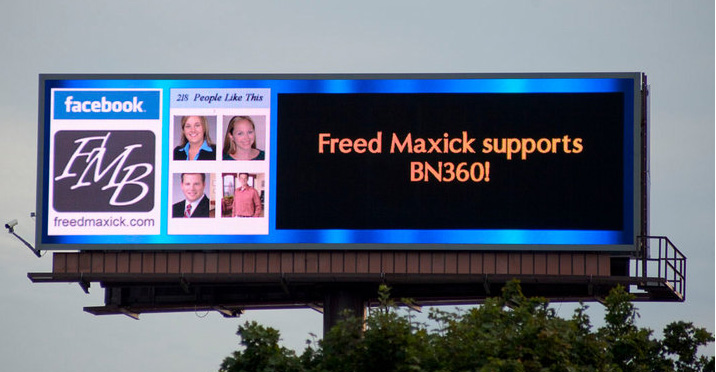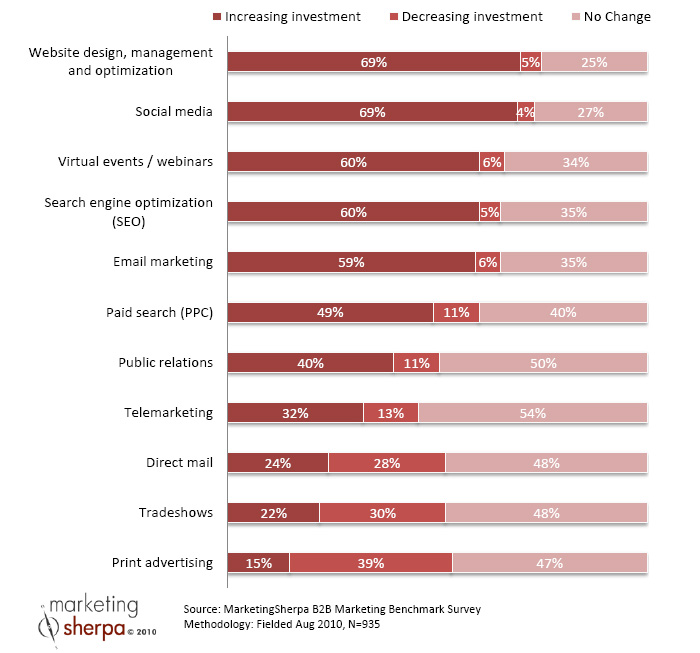|
Sometimes a case study inspires. This happened to me on Tuesday of this week, when Eric Majchrzak, Marketing Director of Freed, Maxick and Battaglia (FMB) presented at the B2B Marketing Summit in Waltham, MA. Eric was speaking on a social media panel about his Buffalo-based CPA firm’s outdoor interactive Facebook billboard. Basically, this billboard projects for all the drivers and pedestrians who pass it by, the most current posting on their Facebook page. But unlike so many other corporate Facebook pages that just talk about themselves, this Facebook page promotes non-profit community events. Genius. The billboard is set up as follows:
It also embraces social media best practices: creates community, encourages dialogue, stimulates interest. By integrating one classic marketing tactic (billboard advertising) with another (social marketing), FMB has more than doubled the impact of both these tactics. A great example of how to integrate social media into the broader marketing context. Furthermore, I'm betting this not only gets them more new clients, but it makes their current ones happy they have FMB as their accountants. Who would have thought that an accounting firm could have thought of this? I just wish I had. Hats off to Eric and the folks at FMB who gave him the green light!
0 Comments
 I just joined over 200 business-to-business marketers at MarketingSherpa’s B2B Marketing Summit in Waltham, MA. There was a panel discussion about social media in the B2B landscape. Members of the panel discussed the value of establishing objectives for your social media marketing. For B2B marketers, the typical objectives are often increasing and nurturing leads, having a conversation with loyal followers, increasing traffic to the website etc. One of the speakers, Vanessa DiMauro from Leader Networks, said that she had worked with a group of law enforcement groups on their social media efforts. And she said they had only one social media objective: to solve more crimes. Now I don’t often think of the police as being in the forefront of the marketing revolution, but what got me about this objective was how it represented thinking outside the box. It incorporated all of the good attributes of social media: conversing, listening, sharing, interacting, going viral, community building. It had nothing to do with using social media to actively promote the value of these law enforcement organizations, and yet at the end of the day, the entire social media program absolutely reinforced the value of these organizations. I love the idea of coming up objectives that are not what everyone else is doing. That’s how to break through the clutter. So how do you come up with them? What I learned from this example is to think in terms of your community rather than think in terms of your company. Your products might offer many wonderful solutions, but talking only about your solutions means you’re still talking at your consumers. Think about their problems, and not just those you can solve. Think bigger picture. For example, if you offer a supplement that helps the joints, don’t just talk about the knees, address the whole body. That widens the conversation to those who don’t need your product now. It also makes you more interesting to those who could benefit from your product. In fact, when thinking about your social media objectives, think about what crimes you can solve within your customer community. In MarketingSherpa’s latest benchmark report on B2B marketing, the trend shows that the majority of B2B organizations are increasing their marketing budgets for inbound marketing tactics. When it comes to outbound marketing tactics, budgets are staying flat or decreasing. So what’s inbound? It’s social media, virtual events and webinars, SEO and PPC. Outbound tactics are telemarketing, direct mail and print advertising. Depending on how it’s used, email falls somewhere in-between. So why the move to inbound? According to Sherpa, “The growing trend of utilizing inbound marketing tactics is a result of the cost effectiveness of these marketing channels and when applied with established sales funnel processes… organizations are able to effectively generate a high volume of qualified leads for their sales teams.” It makes sense that B2B companies look at cost effective and ROI more closely because they were hit hard by the recession and their marketing budgets and staff were slashed. They had to operate smarter, and inbound marketing is all about ‘creative sweat’ combined with a sharp eye on the metrics. So what are the most effective B2B marketing tactics? MarketingSherpa’s report ranks them as follows: Notice how the inbound tactics dominate the outbound ones.
If you are at all interested in finding out more what’s working in B2B marketing, I highly recommend that you read MarketingSherpa’s 2011 B2B Marketing Benchmark Report. In a nutshell, here’s what happened. GAP, the clothing brand, decided to change its logo. They decided on a quiet launch: like it was no big deal. Big mistake. Like they forgot there’s this thing called ‘social media’, Within moments of its unveiling, the chatter on Facebook and Twitter exploded. All negative comments. Compared to the overall GAP consumer base, this was a small group, but it was a noisy one. Pretty soon bloggers from everywhere began posting their opinions of the new logo. They compared it to the “New Coke” and many called the design embarrassing. All in all, a social marketing nightmare.(I’ve posted the two logos. What do you think?) Now GAP didn’t become the company they are today because they’re stupid. Give them credit for their fairly quick response. They put out a press release announcing that they have listened to their customers and will keep the classic blue box logo. Their spin was to compliment the passion of their customers, and since customers always come first, they decided to go back to their original logo.
But here’s the quote that I like best. “We’ve learned a lot in this process. And we are clear that we did not go about this in the right way. We recognize that we missed the opportunity to engage with the online community. This wasn’t the right project at the right time for crowd sourcing. There may be a time to evolve our logo, but if and when that time comes, we’ll handle it in a different way.” Thank you GAP. During this obviously difficult time for the company you have acknowledged the power of social media marketing. So what does this mean for social media marketers in general? Does it mean that all logo redesigns will have to go through a social media evaluation process? I’ve done some logo redesigns in my time and I shudder to think what a process would be like if we opened the design approvals to the social community. What I do see is that once a redesign is determined (and you have to assume that some market research has been considered while redesigning the logo), a careful integrated launch has to be planned, and key to it must be how to communicate with the loyal social media consumer (known to many as a social media marketing campaign). Otherwise the brand will create an ever widening gap between itself and its loyal fan base, and that’s not what any company wants to do.  I spent two days at this year’s Natural Products Expo East, asking marketers of all different size companies to participate in a benchmark study. The study will hopefully reveal marketing practices for the natural products industry, how marketers divide their budgets, and what works for them and what doesn’t in the world of marketing communications. Almost all of them agreed to participate (we’ll see how many actually do when they get the email link). Many of them saw the benefit of having such a report, while others shrugged. Even though the information gathered will be completely anonymous (those taking the survey will not be asked for their company’s name), several sited their privacy as the reason for not participating. All of this was to be expected. There were several marketers who volunteered information – none of which was particularly promising: Information like “We only advertise with the distributors,” or “We don’t do hardly any marketing.” Only a select few mentioned social media (tended to be the bigger companies) and hardly anyone mentioned SEO. The natural products industry, which has more feel good stories to tell than almost any industry I know, which has the potential to create devoted online communities, still is stuck in point-of-sale and trade-oriented marketing. For so many of the small companies I visited, they still believe that the power of their product will be enough to break through the clutter and find its loyal following. While that was the case 15 or even 10 years ago, just having a good product that’s new to the market is not going to cut it. There are a few companies that have burst onto the market in the last couple years, and they did it with the combo of new and a concerted marketing effort. But those little guys in the single booths, I worry about them. Many of them have this mindset that they can’t afford marketing. That’s because they think of it in terms of spending ad dollars. And if they don’t get an immediate bang for their dollars, they stop – and all that precious money they spent is wasted. If only they put the ingenuity that helped make their products into some creative marketing, they might have a chance. I’m talking about creating an organic web presence, one that combines best practices SEO and social media. I’m talking about using the internet cleverly to get to those all important store buyers. They are right about the fact that they need to get onto the shelves. But it takes marketing to bring their products to the attention of those buyers, and it takes marketing to keep their attention as well. Yes, it will cost money, but unlike advertising it will have a lasting effect. It’s the difference between owning and renting: Advertising is like renting and SEO plus social is like owning. One is a place holder and the other is an investment. What these small companies have that really differentiates them is their unique story and their honest desire to do good things for people and their health. If their product is all they say it is and if they start building a small community, then they will see steady growth in awareness and loyalty, and that will translate into increased sales. I can’t wait to see the results for the 2011 Marketing in the Natural Product Industry Benchmark Study when it comes out in January. I’m hoping that it will encourage the smaller companies to commit to smarter and creative marketing. What do you think? |
AuthorArchives
June 2011
Categories
All
|
|
Pioneer Communications Group is a marketing firm that specializes in helping small businesses that want to engage with their customers and prospects effectively, and profitably. We are expert in marketing strategy, communications, market research, marketing automation, and content creation. © 2016-Pioneer Communications Group
|




 RSS Feed
RSS Feed